The bookkeeper in the television maker
Interview with Jef Cornelis on IJsbreker 20: Computer Art
Koen Brams & Dirk Pültau
Table of contents
Chapter 1.
Chapter 2.
Chapter 3.
Chapter 1.
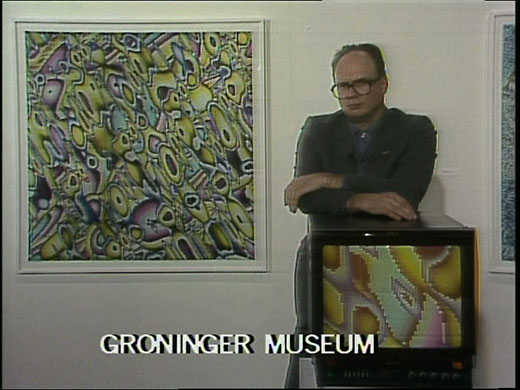
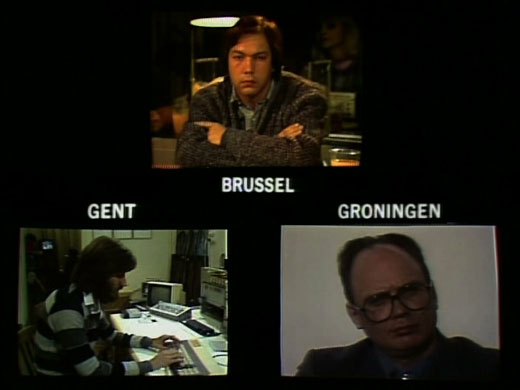
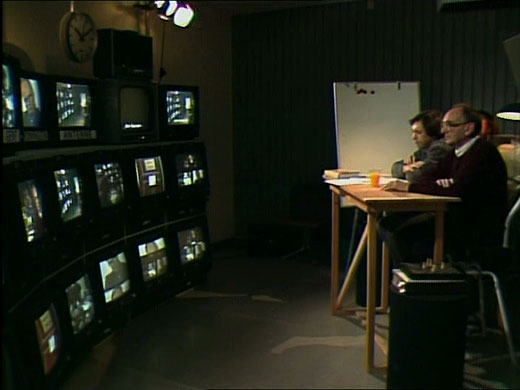
Koen Brams/Dirk Pültau: Episode 20 of IJsbreker [Icebreaker] was about ‘computer art’. Who had come up with that theme?
Jef Cornelis: Pol Hoste and Marianne Van Kerkhoven were the colleagues concerned with content. They worked part time and were alternately responsible for backing up the material in the respective episodes. Did one of them propose the theme? Or did I? It was in any case a theme that came at the right moment. The computer had begun its unstoppable march into our lives. I remember that it was important to me that the Dutch artist Peter Struycken and the Belgian theorist Luc Steels would take part.
K.B./D.P.: Peter Struycken had a solo exhibition at the Groninger Museum at the time.
J.C.: Yes, that was the motivating factor! The Groninger Museum was one of the three locations, along with the studio of Peter Beyls in Ghent and the [VRT] video room in Brussels, where our guests were composer Dick Raaijmakers and information specialist Luc Steels. It had initially been our intention to operate more often in the Netherlands. We eventually had to abandon that idea because the satellite connections from the Netherlands were outrageously expensive. For the IJsbreker broadcast on computer art, we were able to pick up on what we had originally planned to do.
K.B./D.P.: Did you know Peter Struycken?
J.C.: Yes, I think I had already met him, but don't ask me when or where. Hadn't he won the Sikkens Prize in the 1960s? Or had his work been featured in Openbaar Kunstbezit? In any case, he was often at the Visser's — collectors Mia and Martin Visser, whom I also occasionally visited. Was he in contact with Jean Leering? Frans Haks, director of the Groninger Museum, was someone I in any case saw regularly. He too was a visitor at the Visser's and was a fan of my work.
K.B./D.P.: Who thought of Dick Raaijmakers? In 1978, he had published a remarkable text: 'De kunst van het machine lezen' (The Art of the Machine Reading), in Raster no. 6, which was entirely devoted to ‘the art of the machine’.
J.C.: We certainly have consulted that issue of Raster. Had Pol come up with that? It is very possible. How had I met Luc Steels? It is an important question. I had certainly met him before then. Steels was a deciding factor.
K.B./D.P.: Did you perhaps know Steels by way of Annie Gentils's Montevideo program? In 1981, Steels was responsible for the opening exhibition at her experimental art space in Antwerp.
J.C.: No… I suspect I met him in the late 1970s, when I spent a lot of time at the Free University in Brussels, for a film about the profession of architect. Steels was an entrepreneur. He travelled a lot and had very broad interests.
K.B./D.P.: It is striking that Steels was only introduced as an academic, while he was also developing his own artistic activities. This was not mentioned at the beginning of the broadcast, although the program was about computer art.
J.C.: That is true. His double role was not discussed, but you should not read anything into that. Steels was indeed active in the art scene. He had, by the way, invited Peter Beyls to work in his Artificial Intelligence Laboratory, which he had set up at the Free University in Brussels in 1983.
K.B./D.P.: Peter Beyls and Rudi Blondia worked on the broadcast from Beyls’ home on the Coupure in Ghent. How did they become involved in IJsbreker?
J.C.: I immediately sensed a sympathetic figure in Beyls. He was a ‘timid’ propagandist. How did Blondia become involved in the broadcast? Through Beyls — it could not be otherwise. They must have known one another.
K.B./D.P.: In the VRT archives, we found a document which shows that it had originally been the idea to approach the mathematical linguist Hugo Brandt Corstius. The choice ultimately was for Dick Raaijmakers. Why?
J.C.: Brandt Corstius must have refused, but I cannot remember the reason why. I was a big fan of Brandt Corstius's polemical work published in Vrij Nederland — a sharp pen and a bad character. In addition to being a polemicist, he was an expert on computer language, which was the reason for asking him to take part.
TOPChapter 2.
K.B./D.P.: In the undated program proposal for IJsbreker 20, which we found in the VRT archives, we found the following lines: ‘Based on the program for 24 October, there is interest in bringing artists to light who involve electronic machines in their creations: painters, printmakers, photographers, cinematographers, composers, writers, poets, choreographers, architects…. Linguists, mathematicians, logicians, information scientists and neurologists'. But IJsbreker 20 only dealt with two art forms: visual arts and music, and both Peter Beyls and Rudi Blondia were involved in both. Why did you decide on visual art and music?
J.C.: They were the art forms that could most easily be evoked on television. I cannot think of another reason.
K.B./D.P.: Why was no attention given to literature that was then being made with the computer? As early as 1971, Gerrit Krol had published APPI: Automatic Poetry by Pointed Information. That could also have been a good example.
J.C.: Again, I believe it was Peter Struycken's exhibition by at the Groninger Museum that was the catalyst for the broadcast.
K.B./D.P.: Were you interested in the work of Peter Struycken?
J.C.: I thought his work was utterly boring, but I knew he was a good educator.
K.B./D.P.: You could also say that about Luc Steels. At the beginning of the broadcast, he spends a rather long time telling about his reasons for taking part. He rounds off the introduction by showing his laptop, a so-called Symbolic 3600. From the correspondence in the archives, it seems that you wanted him to bring the computer with him. It shows that there was an educational motivation.
J.C.: Do you think I was against educational work? Not at all. By the way, if you watch and listen very carefully, you can learn a lot about the theme.
K.B./D.P.: The introduction to the broadcast takes up a lot of time. First, Luc Steels gives an introduction, then so does Dick Raaijmakers. Then it switches to Groningen, where Peter Struycken invites the public to look at his slides. It is already 26 minutes into the program when Peter Beyls first speaks, and Rudi Blondia had to wait even longer.
J.C.: Beyls could have spoken up. In the 16th IJsbreker, about bodybuilding, it happened regularly. So why didn't Beyls speak up this time?
K.B./D.P.: One possible explanation can be the script decided by Pol Hoste, which he had worked out in detail. In order to introduce the various speakers, he read aloud no fewer than three pages. After 43 minutes, when he finally introduced Rudi Blondia, he spoke the final words of the scenario that he himself had written. For the rest, he is not a presence, although he could have been. For example, he could have asked Beyls what he thought of Struycken's art at an earlier point.
J.C.: It all progressed very calmly. That would be the appropriate conclusion.
K.B./D.P.: Another explanation for Beyls’ waiting so long during the broadcast might be the fact that there had been a rehearsal in advance.
J.C.: Where? In de studio? What do you mean by rehearsal?
K.B./D.P.: An example: When Beyls first speaks, Steels seems to have asked him a question. Beyls says, ‘I misunderstood your question, or was it that aesthetic decisions are left to the [computer] program?’ Couldn't he only have been aware of that 'question' because there had been some kind of rehearsal in advance?
J.C.: Rehearsal – forget about it! All of the directors involved, one at each location, were only at a single meeting beforehand. After the broadcast, we spoke to one another one more time, for the evaluation. They saw no more of each other than that.
K.B./D.P.: Another example: Steels asks Struycken a question and Struycken says, ‘In order to explain that, I need paper.’ He walks to a different space, where a stand with markers and paper are already awaiting him. It had been prepared ahead of time. In the scheduling for the program, there had also been time planned for rehearsals: ‘general rehearsal from 7:45 PM to 9:15 PM’. That is an hour and a half.
J.C.: Do you have any idea how little you can do in an hour and a half? We moreover worked with primitive equipment. That 90 minutes was primarily to ensure that everything was working properly. It is of course also true that after 19 broadcasts, we had the whole formula down pat.
K.B./D.P.: So the fact that Struycken would show slides had been agreed in advance? It is in any case the most boring part of the whole broadcast.
J.C.: If it was not planned, chances are that everything had gone terribly wrong at the Groninger Museum.
TOPChapter 3
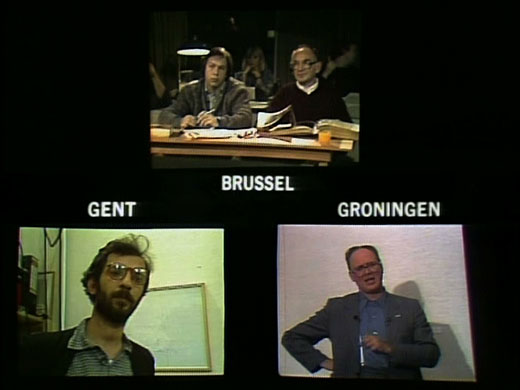
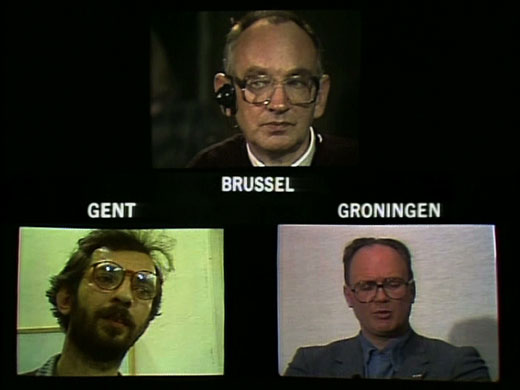
K.B./D.P.: In the VRT archives, we came across a document written by Pol Hoste. In preparing for the broadcast on computer art, he had written two pages identifying themes for the discussion. He had thought up really interesting questions, but not one of them was dealt with during the broadcast. For example, ‘If a computer can translate something like creative thinking into mechanical models, to what degree is it capable of giving the artist an insight into his own creative activity? (And if so, what good is it?)’ Elsewhere, he wrote: ‘That IJsbreker could still become a very erudite program.’
J.C.: That humour – it is typical of Pol! He did indeed prepare extremely well and provided masses of information for myself and Marianne.
K.B./D.P.: So why didn't he join in? He could have brought up so many interesting questions.
J.C.: We didn't really do much on that broadcast, in a certain sense. The speakers made it themselves. It all came together without anybody having to push or pull at it.
K.B./D.P.: Luc Steels plays an important role where that is concerned.
J.C.: And then Pol had to keep quiet; that was the agreement. Steels was very easy-going.
K.B./D.P.: Is it possible that Pol Hoste and Luc Steels had an agreement about it?
J.C.: No, that is impossible.
K.B./D.P.: So it happened spontaneously?
J.C.: Yes. We had to do very little work for that broadcast. The participants made the show themselves.
K.B./D.P.: In a certain sense, Steels takes the role of moderator. He asks very good questions. He asks Struycken, for example, if he had really needed a computer in order to make those pictures. ‘If it didn't take too long, couldn't you just as well have done the painting and the mathematics by hand?’
J.C.: You instinctively sense that he thinks that for Struycken, the computer is just a kind of toy.
K.B./D.P.: Every question that Steels asks is relevant.
J.C.: He knew exactly what he was doing. After that, Raaijmakers did not have a lot more to say.
K.B./D.P.: Luc Steels remains very calm, but he does become increasingly critical. He asks questions that are not explicitly critical, but they are at least implicitly so.
J.C.: Yes, for example about the core of Struycken's art: Is the artistic element in the [computer] programming with which the images are created, or is it in the final products, the images? It is a good question.
K.B./D.P.: Steels does indeed ask critical questions, but it is striking that all the guests are fundamentally in agreement with one another. There is no doubt whatsoever about the basic premise that you can make art with a computer. Why hadn't you invited someone who had a different opinion?
J.C.: Hugo Brandt Corstius was invited, but blew us off. We will never know if he might have had a different opinion.
K.B./D.P.: Why did you not look for a more critical replacement?
J.C.: We undoubtedly did not have enough time to engage someone who had a fundamentally different point of view than artists such as Struycken, Beyls and Blondia.
K.B./D.P.: Something odd is going on at the end of the episode. At a given point, Dick Raaijmakers is speaking and shows a book by Michel-Eugène Chevreul, the French 19th-century chemist who investigated colours and colour combinations. Raaijmakers uses this as a tribute to Struycken, whom he knows to be a great admirer of Chevreul. It looks as though everyone had decided that the episode would end with that, but it doesn't. Why not?
J.C.: As soon as Raaijmakers had made his hommage to Struycken, Steels wanted to add something more about art and science…
K.B./D.P.: …and he came up with what could at the very least be called a surprising statement: ‘I would like to add to that [esthetic criteria] play an equally important role in scientific research.’ Beyls picks up on that and breathes new life into the program.
J.C.: The Head of Directors gave me the green light to continue.
K.B./D.P.: Struycken then takes over Steels's role and puts a critical question to Beyls. He believes he has caught him contradicting himself. Earlier, Beyls had said that he was open to surprises — in contrast to Struycken, by the way — but then he announced that in terms of the medium in which he wanted to work, he always made his decisions in advance. Struycken did not miss his chance to rub that in. There was in fact something of a conflict emerging out of this episode of IJsbreker!
J.C.: Yes, Beyls was very nervous. I felt that clearly.
K.B./D.P.: It is a shame that Struycken and Beyls only crossed swords so late in the broadcast.
J.C.: They had already had sixty minutes to do so. The Head of Directors had given me ten minutes of respite, but then I had to draw it to a close.
K.B./D.P.: A final question: Every IJsbreker broadcast was systematically prepared in the same way. Every step was repeated over again. In that sense, you could say that it was a kind of operation. It was incredibly tightly organized.
J.C.: You can say that, yes. The same protocol was followed every time. That is the bookkeeper in the television maker.
Editing: Koen Brams
Transcription: Soetkin Beerten
Translation: Mari Shields